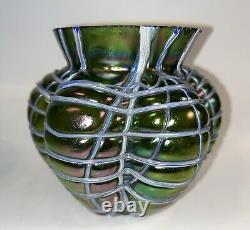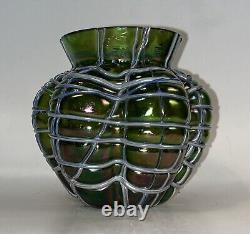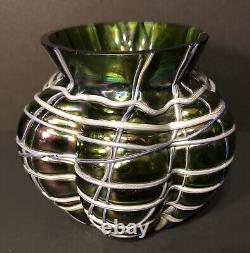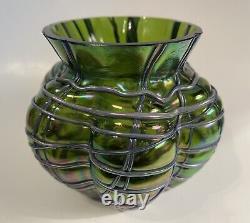
- Homepage
- Age
- Boxed / Unboxed
- Brand
- Alvin (26)
- American Silver (21)
- Antique (89)
- Doulton Lambeth (22)
- Fenton (22)
- Handmade (35)
- Henry Richards (24)
- Kralik (142)
- Legras (25)
- Loetz (367)
- Mont Joye (27)
- Moorcroft (22)
- Moser (42)
- Roostery (24)
- Royal Doulton (38)
- Spoonflower (53)
- Unknown (49)
- Unmarked (175)
- Wmf (33)
- Zsolnay (23)
- ... (3976)
- Material
- Pattern
- Style
- Adams (103)
- Aesthetic Era (7)
- Antique (19)
- Art Deco (75)
- Art Nouveau (2837)
- Arts & Crafts (6)
- Band (12)
- Band, Solitaire (8)
- Bangle (7)
- Chain (29)
- Chain, Pendant (13)
- Cocktail (12)
- Contemporary (14)
- Drop / Dangle (10)
- French (10)
- Pendant (106)
- Pendant, Chain (7)
- Solitaire (17)
- Victorian (30)
- Vintage / Retro (15)
- ... (1898)
Antique Pallme König & Habel Art Nouveau Iridescent Fadendekor Green Glass Vase























This sale is for a Large 5 Pallme-König & Habel Squat 6 Lobed Pumpkin w/Applied Thread / Vein Network on Iridized Glass. Measuring about 4 3/8" in height and 5" in width, this plump pumpkin makes a statement. This Beautiful Vase has an.
Iridescent surface in Green-Violet-Yellow-Magenta that is decorated with Blue-Silver-White melted threads or veins. The squat shape has a Gourd-like Globular belly with six lobes, the veins standing out from the surface creating a textured network all over.
Vase is from around 1900 - so it is in great shape for being over 100 years old! There are several flakes from around the rim AS SHOWN. This piece has a tall enough neck that it could be shortened to get rid of the flaked area, or a silver band could be applied along the top of the neck. Or, you could leave it as is and enjoy it's presence with all of it's flaws from the past century.There is also one area on the body where two thread lines cross and a section of one of them is missing - this is circled in photo 6. I have a second, slightly smaller piece listed as well if you are interested. Please look at all of the photos as they are the best description and ask any questions BEFORE purchasing. THANK YOU for your consideration. The Pallme glassworks was first established in Steinschonau, Austria, in approximately 1786 by Ignaz Pallme-König.
Around the turn of the century they merged with Wilhelm Habel's Elizabethhutte glassworks near Teplitz and became known as "Glasfabrik Elisabeth, Pallme-König and Habel". During the Art Nouveau period, this glass company produced high quality iridized glass. Hot glass trails were wound around the iridized glass forming a network, and the piece was then blown into a mold so that the trails were pressed into the glass. Pallme-König and Habel glass is not usually signed, and does not normally have a pontil mark. The whole vase, with its molten trails on the surface, was normally blown into a mold and then finished from the top.
It is often confused with Loetz glass, the major Austrian glass maker of the Art Nouveau period. Loetz also made iridized glass vases and bowls with trails of glass around the outside.
Very often these kinds of Loetz trails are finer, and are not necessarily in a contrasting color to the vase itself. Loetz also made glass with trails that have been flattened and smoothed to the surface of the vase, again distinctly different from Pallme König and Habel.
